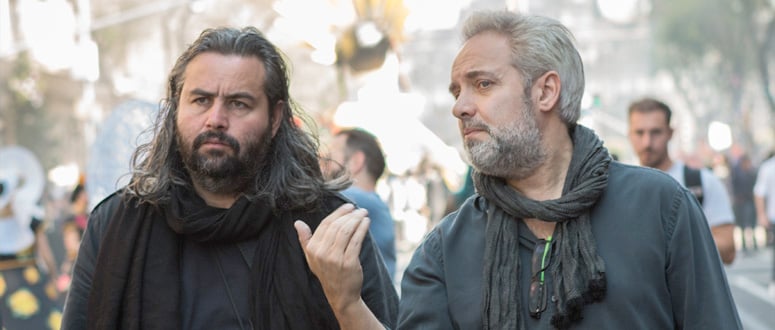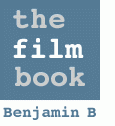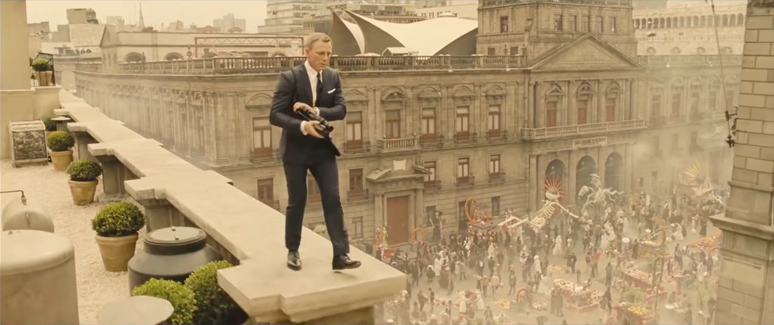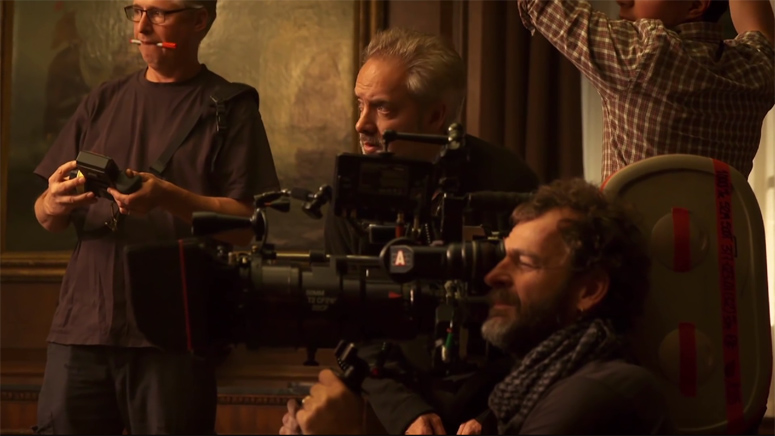
Spectre: Interview with Sam Mendes
An interview with Sam Mendes. The first of two posts about the James Bond movie Spectre, directed by Mendes and shot by Hoyte van Hoytema, ASC, FSF, NSC.

This is the first of two posts that complement my November 2015 American Cinematographer article about Spectre, the latest James Bond movie directed by Sam Mendes, with cinematography by Hoyte van Hoytema, ASC, FSF, NSC.
This interview is with Sam Mendes. Another post describes a few of Hoyte van Hoytema's lighting setups for the film.

1. Sam Mendes
2. Spectre Trailer
3. Conrad Hall
4. Choosing Hoyte
5. The Rooftop Dolly Move
6. The Opening Shot
7. Shooting 35mm Film
8. Real and Fantastic
+++
1. Sam Mendes
Sam Mendes is a multi-talented English film and theater director who has made seven films to date, beginning with the dazzling American Beauty, which won five Oscars, including one for the director. His other films include Road to Perdition, Jarhead, Revolutionary Road and the James Bond movies Skyfall and Spectre. Mendes is also known for his original theater productions of classics by Shakespeare and Chekhov, as well as musicals like Cabaret and Oliver!
For his films, Mendes has consistently worked with eminent cinematographers, beginning with Conrad Hall, ASC, who won an Oscar for American Beauty and a posthumous Oscar for Road to Perdition. Mendes also did three films with Roger Deakins, ASC, BSC, and one with Ellen Kuras, ASC, before making Spectre.
+++
2. Spectre Trailer
watch on YouTube
+++
3. Conrad Hall
Benjamin B: You have always sought out stellar cinematographers, starting with the late, great Conrad Hall.
Sam Mendes: The cinematographer has always been the single most important member of my team, and I was very clear about that from the start. When I was trying to find a cinematographer for American Beauty, I remember saying to DreamWorks, 'I don’t mind perhaps using some younger people in other departments, but I want to work with a great cinematographer.' And they agreed to let me use Conrad. At the time, there was a slight stigma attached to him, because he was considered slow and old school.
The truth is, there was, and to a degree still is, a suspicion of 'old school' cinematographers — and by that I mean people who really light and take the time to work in detail. I think that’s been exacerbated somewhat by the advent of DI and other trickery that can be used to adjust the lighting after the event. Now, less importance is given by the studios to proper lighting, and there’s even less understanding about what that is.
When we were shooting Road to Perdition, I remember [producer] Dick Zanuck saying, 'Conrad’s lighting every fucking blade of grass.' It’s a great phrase. Then, he saw the movie and said, 'You know the thing I said about every blade of grass?' I said, 'Yeah,' and he said, 'What a fucking masterpiece the cinematography is.'
I miss Conrad all the time, as a friend. He was just a great man, really, a wonderful human being. I think of him often.
+++
4. Choosing Hoyte
What made you choose Hoyte for Spectre? Compared to Conrad Hall or Roger Deakins, Hoyte at present is a less established cinematographer.
Mendes: He is. I was very taken by his work with Tomas Alfredson on Let the Right One In and Tinker, Tailor, Soldier, Spy, both beautifully lit. Then I saw Spike Jonze’s movie Her, and I thought, “My god, Hoyte’s managed to make digital look so soft and romantic and evocative, and he’s taken all that sort of harshness out of it.' Then Chris Nolan, who’s a friend and colleague, showed me Interstellar before it came out so that I could see Hoyte’s work.
I couldn’t just drop a newcomer in to fill Roger’s shoes unless I felt he had the capacity to be as good, if not better. I talked to Chris and Spike about Hoyte, and they both said he’s the real deal. I trust directors of that caliber. Having now worked with Hoyte, I feel that he’s in the same league as Roger and Conrad without a shadow of a doubt. He’s a real artist and, like them, he’s paid his dues. He’s worked on all sorts of different scales with all sorts of productions, small movies and big movies, with great filmmakers.
Hoyte comes from the European tradition, but he understands American filmmaking. He has his own very unusual and very particular aesthetic. He's daring, and has a wonderful energy on the set. He’s very sharp with clichés, very quick to pick up things that he feels are too well trodden, but he also understands classic filmmaking.
+++
5. The Rooftop Dolly Move

+++++


+++
6. The Opening Shot
I want to ask you about the opening scene in Mexico City, where you combine three shots to create an apparently continuous four-minute take during the Day of the Dead celebration. The seamless transition from Technocrane to Steadicam and back is brilliantly executed, as you follow Bond through a crowd on the street, into a hotel and up an elevator, into a hotel room, then out the window and onto the rooftop. What does the simulation of a long single take bring to the viewer, to the movie?
Mendes: I wanted to drop us into Bond’s shoes. The single take says to the audience: 'This is happening in real time. That’s Bond; you’re going to travel with him; he’s going to be your journey through this section of the movie, so settle in. Just watch and concentrate; we’re not letting you off the hook; see how far you can go with us. By the time you get to the end of this shot, you’re in.' And I love that feeling. That’s what Altman did brilliantly at the beginning of The Player, and, of course, Orson Welles at the beginning of Touch of Evil.
Everyone kind of knows that the first 10 minutes of a Bond movie are going to be some kind of action, that there’s going to be a big sequence of some sort. So, in a way, it gives you freedom to be a little bit more daring. In this case, it’s not about planes, trains and automobiles, but first-person action in a very rich, fantastic atmosphere.
There’s a great Hitchcock phrase. He was asked why he always cast big stars like Jimmy Stewart, Cary Grant, and Grace Kelly. I’m paraphrasing, but his answer was, 'A star saves me 10 minutes of exposition. I don’t have to explain what the essence of Cary Grant is, or Jimmy Stewart, because the audience already knows this person.' This is true to the nth degree with Bond: not only do you feel like you know Daniel Craig after three Bond movies, you also have had many other experiences with the character. That buys the filmmaker time at the beginning of a movie, because you don’t have to immediately set out your story by giving context, telling the audience who the characters are, or anything like that. You can start in the middle.
I wanted to make full use of that freedom in Spectre and drop the audience right into the middle of something, and give them almost no signposts. Put them in the middle of a labyrinth and let them work their way out of it with the character. And then, gradually reveal story later.
At one time, I wanted the whole first 10 minutes to be one shot, but then I decided that would be self-serving, a bit of a showoff. And, in fact, it was better for dramatic reasons to go into more conventional storytelling and start cutting. That's not to say that the cutting section is in any way easier; when you go into more conventional filmmaking, it’s much, much more time-consuming.
The nice thing about one shot is, you might take a day to shoot your minute and a half, but then you’ve got a minute and a half! That’s a lot of film for a Bond movie to shoot in a day. So that was another reason. Also, I felt that there is a kind of cockiness about Bond at the beginning of the movie, before something goes wrong, that was implied by not cutting.
+++
7. Shooting 35mm Film
You shot Skyfall with Roger Deakins on the Alexa. I believe it was Hoyte who first suggested shooting Spectre on 35mm film negative.
Mendes: I love digital. I felt the Alexa was very potent and beautiful in the nighttime scenes of Skyfall, particularly in Shanghai, in the office building and the nighttime casino, two sequences which were brilliantly shot and lit by Roger. But digital felt less romantic, less textured in many of the exteriors. And under bright light I felt it was difficult to control, harsh on actors, less forgiving ….
With the Alexa, I missed the routine of film and the dailies. Film takes a leap up from your slightly shitty monitor screen to the dailies, where it starts to really have richness. Watching dailies on the big screen for the first time is kind of like Christmas. With film, there’s something to look forward to, whereas with digital, I've always felt that the best version of the image is standing alongside the DIT on set, and there’s a step backwards when you watch dailies. And the DIT adds another figure on set, which I feel can disperse slightly the energy between the cinematographer and the director on a good day.
I’m very pro-digital, but I’m also extremely pro-film. When I asked Ang Lee, whose work I admire very much, about digital and film, he said he likes both, but he finds it difficult when digital tries to look like film. I think that’s very well put.

I loved shooting on film again. Film is difficult, it’s imprecise, but that’s also the glory of it. There’s a magic there; you win big and sometimes you lose big, but the risk is worth it. I was so relieved watching the first day’s dailies on film. It had romance, a slight nostalgia, which was my own imposition, but I had that feeling. And that’s not inappropriate when dealing with a classic Bond movie.
So, I definitely will shoot movies on film again, but I will also occasionally shoot a movie on digital for reasons that have to do with aesthetics and probably speed, or the subject matter and the style in which I want to make it … but I don’t think I’ll ever try to make digital look like film. That’s something I would like to avoid.
+++
8. Real and Fantastic
Hoyte mentioned that you two spoke about evoking a 'classic' quality in the look of the film.
Mendes: Yeah, classic, old school. My touchstones are the Bonds of the Sixties, the Bond of Terrence Young, Dr. No, From Russia With Love and Goldfinger. A little bit with Roger Moore and To Live and Let Die. Those were my influences from within the genre, but in Spectre there is also a kind of timelessness.
The difficulty with Bond is always marrying the real with the fantastic. You can’t disengage entirely from the real world. You can’t go and make a Marvel film, and you’re not J.K. Rowling, but on the other hand, you're not Bourne, either. Bond does not walk amongst us; he’s separated by a force field around him. So it’s about finding that middle ground which seems to be pure Bond. Often, it’s taking what you can find in the world and reorganizing it so that you see it a little bit differently for the first time. But you can’t defy the laws of gravity or physics.
Where I think the Bond franchise went badly wrong was when they had an invisible car. I mean, now it seems almost preposterous that anyone would try that in a Bond movie, but at the time, there was a kind of crisis of identity with the franchise, and they were trying to work out who they were. That was wrong. You can’t push it that far. You can’t give someone a gadget that is not credible.
Stylistically, the movie has to live in the real world yet somehow possess that ache, that longing for another time, another era, another reality. It has to hark back and forth at the same time — a tricky balance. There are sections of this movie, I think particularly Mexico City and the Sahara, which really feel sort of timeless. It could be any time in the last 50 or 60 years. It’s about trying to find that balance between the old and the new.
+++
LINKS
thefilmbook: Hoyte van Hoytema, ASC, FSF, NSC - Lighting Spectre
wikipedia: Spectre
YouTube: The action of SPECTRE
YouTube: SPECTRE vlog features Day of the Dead festival
YouTube: Director Sam Mendes On SPECTRE
wikipedia: Sam Mendes
wikipedia: Hoyte van Hoytema
American Cinematographer: Let The Right One In
thefilmbook YouTube channel: cinema history: 1-shot scenes
YouTube: Touch of Evil opening shot
+++
Our thanks to Sam Mendes and Hoyte van Hoytema
Thanks also to Melanie Jones and Kate Rosenbaum for their help.
A special thanks also to Heather Callow.
Unit photography by Jonathan Olley, François Duhamel, Stephen Vaughan and Jasin Boland, SMPSP, courtesy of Metro-Goldwyn-Mayer Studios, Inc.; Danjaq, LLC; and Columbia Pictures.
+++







